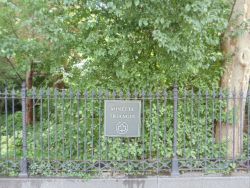Minetta Triangle
Minetta Square
This small park is named for a not-quite-gone and not-quite-forgotten water feature of Lower Manhattan. When Dutch colonists settled in Manhattan in the 1620s, they learned from local Native Americans about a small brook that was full of trout. It originated near what is now Gramercy Square, burbled its way through (mostly beneath) Greenwich Village, and emptied into the Hudson at what is now West Houston Street.
Local Native Americans called the stream "Mannette," which was translated as "Devil's Water." Over the years, this name was spelled and respelled and spelled again in a variety of configurations: Minnetta, Menitti, Manetta, Minetta, Mannette, and Minetto. The Dutch called the water Mintje Kill, meaning small stream. In Dutch, "min" translates as little, "the" is a diminuitive, and "kill" translates as stream. The water was also known as Bestavers Killitie, Bestevaas Kelletye, Bestavens Killitie, Bestavers Killatie, and Bestaver's Killetje.
Several families of freed slaves, released by the Dutch, established farms and homes along the Minetta Brook as early as the 1640s. With African-Americans continuing to settle here in the 18th and 19th centuries, the area became known as "Little Africa." Most of the brook has been covered over, though some Village residents can claim that it flows beneath their basements and sometimes causes flooding. In the lobby of the apartment building at 2 Fifth Avenue, there is a transparent tube that is said to contain murky water spouting up from Minetta Brook. The brook's most recent claim to fame is providing the namesake for the Minetta Tavern, one of the original watering holes of the Beat generation.
Minetta Square, located at the northeast corner of the Avenue of the Americas and Minetta Lane, is one of three nearby parks named after the feisty brook. The City of New York acquired this parcel in 1925 as part of the southerly extension of Sixth Avenue (now Avenue of the Americas). The .075 acre was deemed excess and was assigned to Parks in 1945.
In 1998 the City Council and the Manhattan Borough President funded the $742,000 reconstruction of Minetta Green and two other nearby parks, Downing Playground and Minetta Square. The rigid geometry of Minetta Green was transformed with new trees and shrubs and the creation of a curvilinear bluestone path which features images of trout. The garden path is punctuated by small circular sitting areas with circular tree benches, world's fair benches, boulders and fluted cast iron urns. Small mounds were built up in the interior of the path to add interest to the previously flat landscape and create more of a pastoral setting. The once predominantly concrete sitting areas have become green garden coves.
Check out your park's Vital Signs
Clean & Safe
Green & Resilient
Empowered & Engaged Users
Share your feedback or learn more about how this park is part of a
Vital Park System





